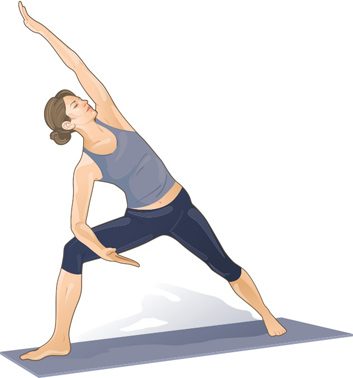
1. The extended warrior stretch
Does your job have you stressed out? Try yoga. A recently published study found that just 20 minutes of yoga during your lunch hour can reduce stress and improve sleep. “Subjects said they didn’t feel as stressed during the eight weeks of doing yoga meditation as they did 30 days before,” says the study’s lead author, Maryanna Klatt of The Ohio State University. Here’s one move to try.
Technique: Standing with feet apart, turn your left foot in and right foot out. Reach your arms out. Lean to the right, bending your right knee so your left leg goes straight. Touch your right elbow to your right thigh, and lift your left arm above your head. The left side of your body should form a straight line from ankle to fingers. Return to starting position; repeat on the other side.
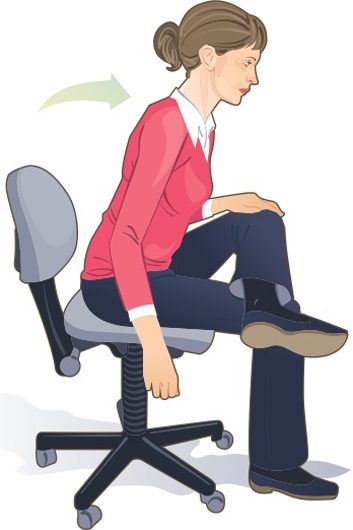
2. The seated glute stretch
For runners and walkers, stretching the gluteus maximus (butt muscles) improves flexibility and can help prevent injuries. Jari Love, a Calgary-based trainer and the host of workout DVD Get Extremely Ripped! 1000, says not stretching the muscles around her hip joint led to piriformis syndrome, ending her competitive running career. She offers Best Health readers this move. You can do it after an exercise warm-up, and daily, whether at home or at your workplace.
Technique: Sit on a chair; bring one ankle up onto the knee of your other leg. Lean forward, keeping your back straight, and you should immediately feel the stretch in the gluteus maximus. Hold for 16 seconds. Love says: “At that point, the muscles start to relax and you are able to go deeper into the stretch.” Continue forward as far as you can comfortably go, pushing gently on the top knee with your hand. Hold for 30 seconds, then switch sides.
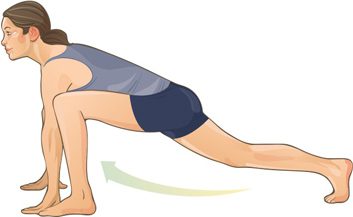
3. “Spiderman” lunges
These lunges stretch your groin and adductors, the small muscles along the inside of the tops of your legs all the way down the thighs. That improves flexibility, says Toronto certified strength and conditioning specialist Craig Ballantyne, author of Turbulence Training. Do this stretch every day and before exercise.
Technique: On hands and toes, tighten abs; lift the left foot and bring it up toward left hand. Right leg stayes extended behind you. (Beginners should go halfway between the arm and the waist. As mobility increases, move foot up to the hand.) Hold for two seconds. Return to the start and stretch right leg forward. Complete six full sets.
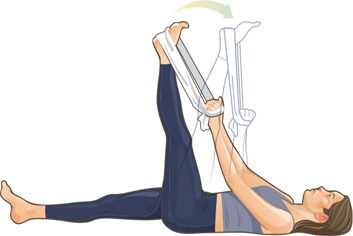
4. Hamstring stretch
You should stretch your hamstrings-tendons that run along the backs of your thighs-every day. “Your posture is dependent on it,” says Tracy Hagan, a trainer and yoga instructor in Regina. Because we have more weight up front than men, women’s bodies tend to lean forward slightly, and that puts a strain on the lower back muscles. And the pelvis acts like a bridge between the lower back muscles and the hamstrings. Lengthening your hamstrings by stretching them regularly means they’ll pull on your lower back less, improving posture and reducing back pain.
Technique: Warm up with a quick, light jog on the spot. Sit on the floor and, holding a towel with both hands, slip it under your left foot. Bend the left knee slightly and lie back, with the left leg in the air and the right one flat on the floor. “Keep the [stretching] leg as straight as possible-only a slight bend at the knee-and both hips on the floor,” says Hagan. Stopping your hips from lifting off the floor allows the hamstrings to really lengthen. Hold the raised foot above your body until you feel slight tension along the back of your leg from the buttocks to knee (but never to the point of pain). “Hold for up to a minute if you can, to get the best result.” Switch legs.
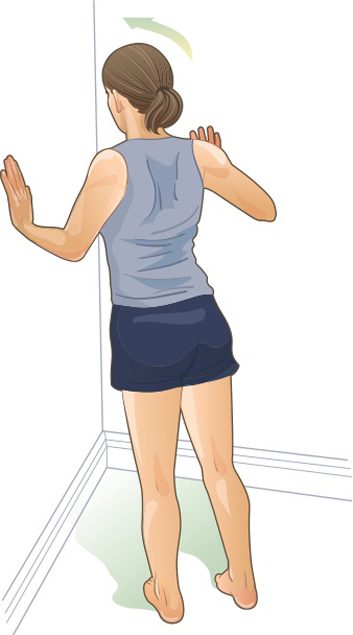
5. Chest and shoulders stretch
When golf and tennis season hits, it’s a good idea to stretch your shoulders and chest. When you lift your arm-for example, when swinging a racket-you reduce the space between the upper arm and the top of the shoulder, which can pinch tendons in the rotator cuff. And repeatedly reaching forward can cause chest muscles to shorten, pulling shoulders forward and resulting in further pinching, says physiotherapist Brian Hiscock, president of the P.E.I. branch of the Canadian Physiotherapy Association.
Technique: Stand about a foot and a half out from the corner of a room, with your feet shoulder-width apart. Place hands on walls with fingertips at shoulder height. Lean forward to feel a stretch across the chest-your shoulder blades should come closer together. Hold for 20 seconds, but not to the point that you are uncomfortable. Do one to three repetitions.
Related:
• 6 essential cool-down stretches
• A new way to stretch out back pain
• 5 workout mistakes
